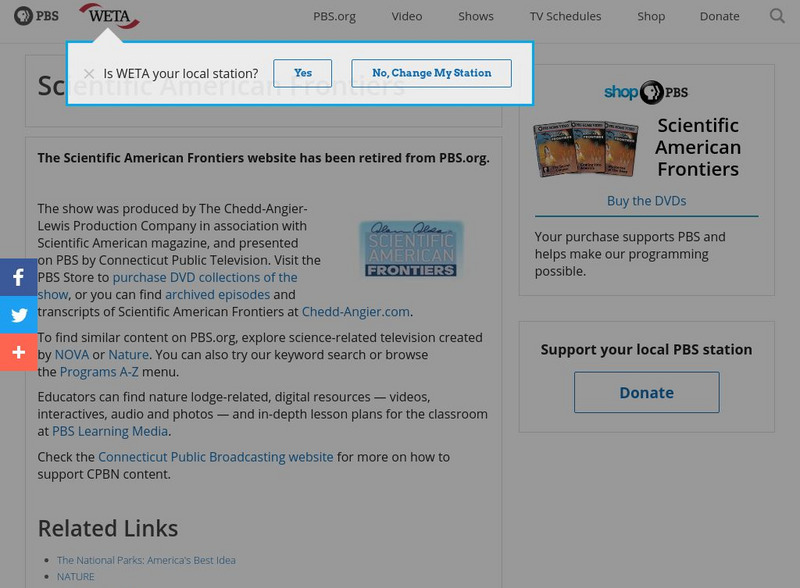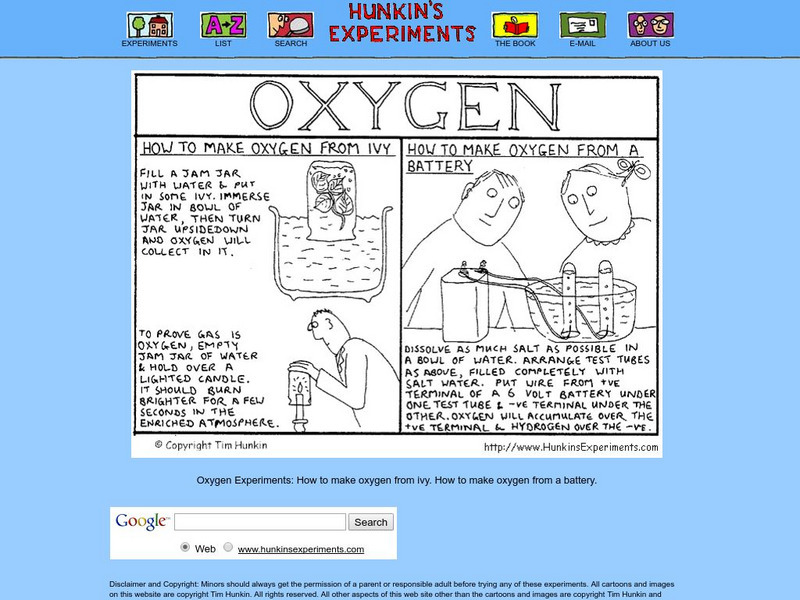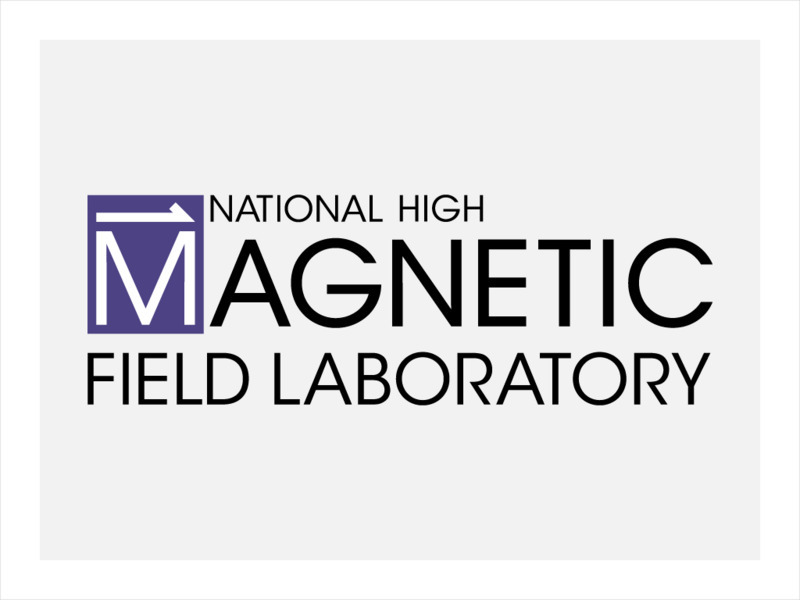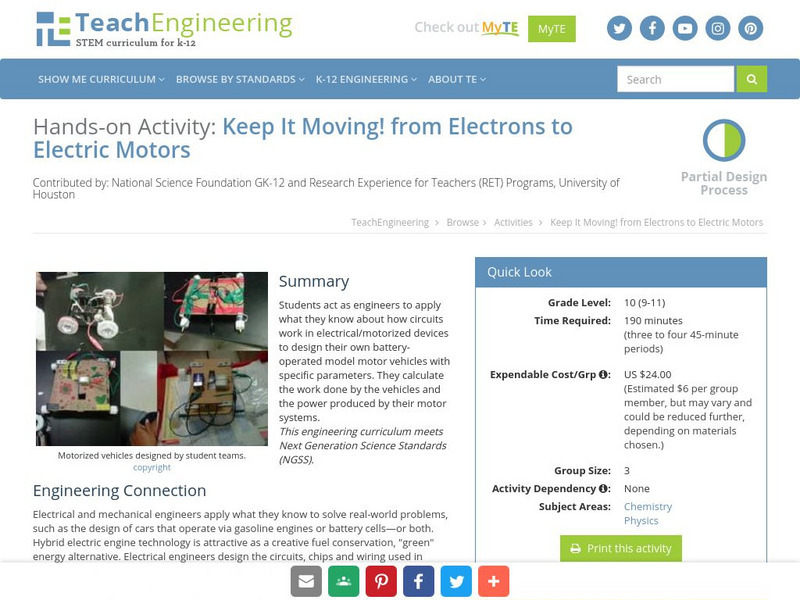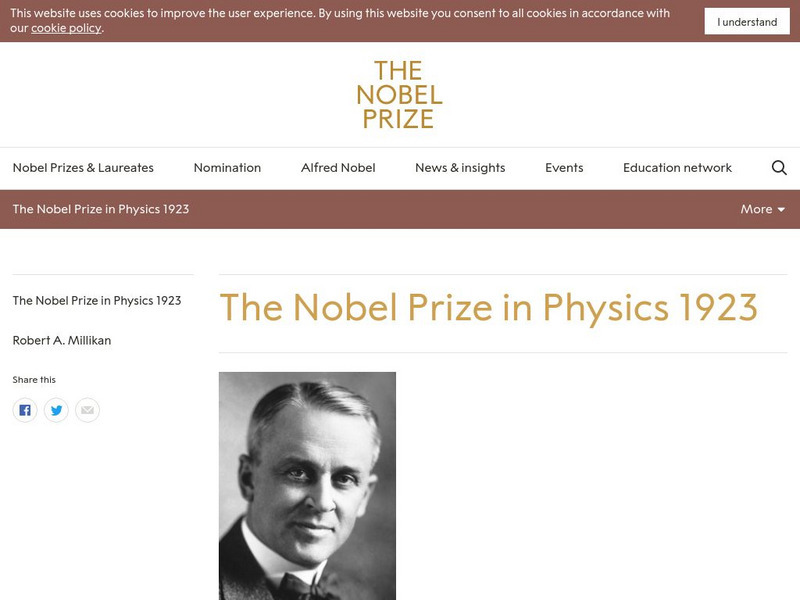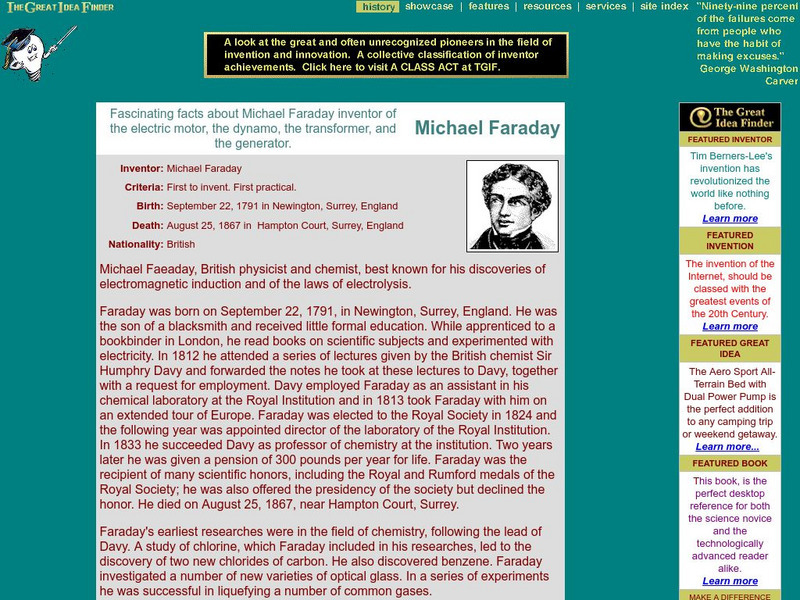Concord Consortium
Concord Consortium: How Can a Small Spark Start a Huge Explosion?
In this Activity 1 investigates What makes materials different from each other? Students will continue to learn about energy and to investigate how energy changes relate to changes in matter. Students will also explore what makes...
Science4Fun
Science4 Fun: Michael Faraday
Brief biographical sketch of Michael Faraday, famous scientist whose discoveries include electromagnetic rotation, Benzene, electromagnetic induction, and Laws of Electrolysis.
PBS
Pbs Teachers: Scientific American: Journey to Mars: Out of Thin Air
Discuss facts about Mars and investigate scientists' efforts to create fuel from materials found in space. Perform a simplified method of aqueous electrolysis to split water into its two chemical elements using electric current from a...
Hunkins Experiments
Hunkin's Experiments: How to Make Oxygen From a Battery
Hunkin's Experiments is a group of simple cartoon illustrations of scientific principles. Some would work well in the classroom, but others have little value beyond entertaining students. All of the projects are easy to do. This one...
Chiral Publishing
Chiral Publishing: An Introduction to Chemistry: Voltaic Cells: Audio Book
Listen and learn how the battery converts energy using voltaic cells. Learn how anodes and cathodes aid in oxidation and reduction. Discover how voltage and electrolysis direct the current.
MadSci Network
Mad Scientist Network: Nonproduction of Oxygen
From the Mad Scientist Network, this page (and its accompanying answer page) use a question and answer format to help explain the results of an electrolysis of water experiment. Helpful tips for performing such an experiment are given.
PBS
Pbs Teachers: Scientific American: Future Car: Fuel Cells
Investigate the innovations surrounding fuel cell technology and the potential use of hydrogen as an automobile power source. Generate hydrogen gas by splitting water in a process called electrolysis.
Science Buddies
Science Buddies: Project Ideas: Salt Bridge: Electricity Changes P H
This chemistry science fair project uses a very simple experimental setup - a battery hooked up to two solutions, connected by a salt bridge - to explore some complex chemistry. The Science Buddies project ideas are set up consistently...
University of Minnesota
University of Minnesota: Ships: Science & Religion of Michael Faraday
Here's a whole different look at Faraday. His religion, Sandemanian, greatly influenced both his life and his science. This article looks deeply at that aspect of his life.
National High Magnetic Field Laboratory
Magnet Academy: Svante Arrhenius
Svante Arrhenius was born in Vik, Sweden, and became the first native of that country to win the Nobel Prize. The award for chemistry was bestowed to him in honor of his theory of electrolytic dissociation. Arrhenius also developed the...
TeachEngineering
Teach Engineering: Keep It Moving! From Electrons to Electric Motors
Students act as engineers to apply what they know about how circuits work in electrical/motorized devices to design their own battery-operated model motor vehicles with specific paramaters. They calculate the work done by the vehicles...
Nobel Media AB
The Nobel Prize: The Nobel Prize in Physics 1923: Robert Andrews Millikan
This Nobel website on the life and scientific work of Robert A. Millikan includes a biography, images, and internet resources for further reading and research. Also included are the 1923 "Presentation Speech" which praised Millikan's...
American Chemical Society
Middle School Chemistry: Energy Levels, Electrons, and Covalent Bonding
Young scholars discover the concept that two atoms can attract and form a covalent bond.
Energy for Sustainable Development
Esd Bulgaria: Kids & Energy: Energy Pioneers: Michael Faraday (1791 1867)
A profile of Michael Faraday, a British scientist who discovered electromagnetic induction, which made it possible to develop the technology for generating electricity. He produced many other inventions, some of which are described here.
Great Idea Finder
The Great Idea Finder: Michael Faraday
A solid biography of good length and history of Faraday's work. Complete, readable, thorough. Picture. Lots of links to other sources, including Joseph Henry's claim that *he* was first, and another about Faraday's kinetic flashlight!
Simon Fraser University
Chem1 Virtual Textbook: All About Electrochemistry
The eight pages in this section of the Chem1 Virtual Textbook cover elementary electrochemistry at a level suitable for first-year college and advanced high school courses.
National High Magnetic Field Laboratory
Magnet Academy: Timeline of Electricity and Magnetism: 1800 1819
Alessandro Volta invents the first primitive battery, discovering that electricity can be generated through chemical processes; scientists quickly seize on the new tool to invent electric lighting. Meanwhile, a profound insight into the...
American Chemical Society
Middle School Chemistry: Energy Levels, Electrons, and Covalent Bonding
Discover how covalent molecular bonding affects the energy levels of electrons.
Concord Consortium
Concord Consortium: Where Does All the Energy in an Explosion Come From?
In this module Activity 3 investigates What changes in energy occur when atoms rearrange during a chemical reaction? This activity explores the relationship between energy and chemical reactions. A bonus reading includes Energy and...
Concord Consortium
Concord Consortium: What Happens to the Energy of Water Molecules During Hurricanes?
Activity 2 investigates How Hot Can Water Get? In Activity 2 students analyze the relationship between energy changes and phrase changes as they discuss what happens when water boils. Bonus reading includes Why is Temperature Constant...
Other
The Science House: Production of Hydrogen
In this experiment, students generate hydrogen gas and examine its properties. Teacher's notes are included.
Curated OER
Educational Technology Clearinghouse: Clip Art Etc: Michael Faraday
(1791-1867) British scientist, chemist, physicist, and philosopher who greatly contributed to the fields of electromagnetism and electrochemistry. His main discoveries include the magnet field, electromagnetic induction, diamagnetism,...
Science and Mathematics Initiative for Learning Enhancement (SMILE)
Smile: Electrochemistry
A teacher lesson plan which could be easily converted into an idea for a student project or presentation. This page describes activities in which the interconversion of chemical and electrical energy are investigated. Complete activity...
Other
Case Western Reserve Univ.: Electrochemistry Dictionary
Dictionary containing definitions of words and phrases used in electrochemistry.
Other popular searches
- Electrolysis of Water
- Electrolysis Copper
- Catalyst and Electrolysis
- Electrolysis Copper Sulphate
- Chemistry Electrolysis
- Electrolysis Water
- Experiment Electrolysis
- Electrolysis Lab
- Hoffman Electrolysis
- Hofmann Electrolysis
- Electrolysis of Copper
- Electrolysis of Aluminium

